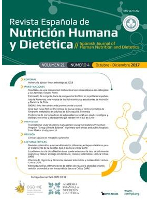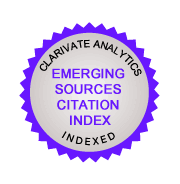Diagnostic accuracy of Triglyceride-Glucose Index for diagnosis of metabolic syndrome in a primary care facility of the San Martin region, Peru. A cross-sectional study.
DOI:
https://doi.org/10.14306/renhyd.28.4.2185Keywords:
Metabolic Syndrome, Blood Glucose, Triglycerides, Routine Diagnostic Tests, ROC CurveAbstract
Introduction. In recent years, multiple studies throughout the world have shown that the Triglyceride Glucose Index has adequate diagnostic performance in patients with metabolic syndrome. The objective of the present study was to determine the usefulness of the Triglyceride Glucose Index for the diagnosis of Metabolic Syndrome in patients treated in a primary care facility in the Peruvian jungle during the period 2022-2023.
Methods: A quantitative, observational, analytical, retrospective, and diagnostic test type design was used. A sample size of 363 patients was calculated, which were divided into two groups according to the presence or absence of metabolic syndrome.
Results: A cut-off point of 8.97 was obtained for ITG values with a sensitivity of 89.5% and a specificity of 64.3% for the diagnosis of metabolic syndrome. The area under the curve (AUC) for ITG was 0.889 (95% CI: 0.851 - 0.922, p<0.005). Additionally, the positive predictive values (82.49%), negative (76.42%) and diagnostic accuracy (80.72%) were calculated. Based on the local prevalence of metabolic syndrome in the studied population, the Fagan normogram was prepared and the positive (2.505) and negative (0.1641) likelihood ratios were obtained, from which the post-test probability was calculated. when the test was positive (82%; 95% CI: 79-86%) and when the test was negative (23%; 95% CI: 17 – 31%).
Conclusions: The present study indicates that the Triglyceride Glucose Index is a reliable diagnostic tool to evaluate the presence of metabolic syndrome in high-risk individuals.
References
Rus M, Crisan S, Andronie-Cioara FL, Indries M, Marian P, Pobirci OL, et al. Prevalence and Risk Factors of Metabolic Syndrome: A Prospective Study on Cardiovascular Health. Med Kaunas Lith. 25 de septiembre de 2023;59(10):1711.
Ananthy V, Priyadharsini RP, Subramanian U. Pathogenesis, Diagnosis, and Management of Metabolic Syndrome: A Comprehensive Review. SBV J Basic Clin Appl Health Sci. 27 de julio de 2021;4(2):39-45.
Jamali Z, Ayoobi F, Jalali Z, Bidaki R, Lotfi MA, Esmaeili-Nadimi A, et al. Metabolic syndrome: a population-based study of prevalence and risk factors. Sci Rep. 17 de febrero de 2024;14(1):3987.
Sanchez-Samaniego G, Mäusezahl D, Carcamo C, Probst-Hensch N, Verastegui H, Maria Hartinger S. Metabolic syndrome in rural Peruvian adults living at high altitudes using different cookstoves. PLoS ONE. 8 de febrero de 2022;17(2):e0263415.
Gelaye B, Tafur LR, Lopez T, Sanchez S, Williams MA. Prevalence of metabolic syndrome and its relationship with leisure time physical activity among Peruvian adults. Eur J Clin Invest. octubre de 2009;39(10):891-8.
Krupp K, Adsul P, Wilcox ML, Srinivas V, Frank E, Srinivas A, et al. Prevalence and correlates of metabolic syndrome among rural women in Mysore, India. Indian Heart J. 2020;72(6):582-8.
Lee SH, Park SY, Choi CS. Insulin Resistance: From Mechanisms to Therapeutic Strategies. Diabetes Metab J. enero de 2022;46(1):15-37.
Lopez-Jaramillo P, Gomez-Arbelaez D, Martinez-Bello D, Abat MEM, Alhabib KF, Avezum Á, et al. Association of the triglyceride glucose index as a measure of insulin resistance with mortality and cardiovascular disease in populations from five continents (PURE study): a prospective cohort study. Lancet Healthy Longev. 1 de enero de 2023;4(1):e23-33.
Ferreira JRS, Zandonade E, Bezerra OM de PA, Salaroli LB. Insulin resistance by the triglyceride-glucose index in a rural Brazilian population. Arch Endocrinol Metab. 21 de octubre de 2022;66:848-55.
Jin JL, Cao YX, Wu LG, You XD, Guo YL, Wu NQ, et al. Triglyceride glucose index for predicting cardiovascular outcomes in patients with coronary artery disease. J Thorac Dis. noviembre de 2018;10(11):6137-46.
Khalid M, Alkaabi J, Khan MAB, Adem A. Insulin Signal Transduction Perturbations in Insulin Resistance. Int J Mol Sci. 10 de agosto de 2021;22(16):8590.
James DE, Stöckli J, Birnbaum MJ. The aetiology and molecular landscape of insulin resistance. Nat Rev Mol Cell Biol. noviembre de 2021;22(11):751-71.
Yu X, Wang L, Zhang W, Ming J, Jia A, Xu S, et al. Fasting triglycerides and glucose index is more suitable for the identification of metabolically unhealthy individuals in the Chinese adult population: A nationwide study. J Diabetes Investig. 2019; 10(4):1050-1058. doi: 10.1111/jdi.12975.
Jiang M, Li X, Wu H, Su F, Cao L, Ren X, et al. Triglyceride-Glucose Index for the Diagnosis of Metabolic Syndrome: A Cross-Sectional Study of 298,652 Individuals Receiving a Health Check-Up in China. Int J Endocrinol. 2022; 3583603. doi: 10.1155/2022/3583603.
Primo D, Izaola O, de Luis DA. Triglyceride-Glucose Index Cutoff Point Is an Accurate Marker for Predicting the Prevalence of Metabolic Syndrome in Obese Caucasian Subjects. Ann Nutr Metab. 2023;79(2):70-77. doi: 10.1159/000526988.
Unger G, Benozzi SF, Perruzza F, Pennacchiotti GL. Triglycerides and glucose index: A useful indicator of insulin resistance. Endocrinología y Nutrición. 2014 ;61(10):533–40. doi: 10.1016/j.endonu.2014.06.009.
Yang H, Chen Y, Liu C. Triglyceride-glucose index is associated with metabolic syndrome in women with polycystic ovary syndrome. Gynecol Endocrinol. 2023;39(1):2172154. doi: 10.1080/09513590.2023.2172154.
Couto AN, Pohl HH, Bauer ME, Schwanke CHA. Accuracy of the triglyceride-glucose index as a surrogate marker for identifying metabolic syndrome in non-diabetic individuals. Nutrition. 2023;109:111978. doi: 10.1016/j.nut.2023.111978.
Auriemma RS, Pirchio R, Liccardi A, Scairati R, Del Vecchio G, Pivonello R, et al. Metabolic syndrome in the era of COVID-19 outbreak: impact of lockdown on cardiometabolic health. J Endocrinol Invest. 2021;44(12):2845–7. doi: 10.1007/s40618-021-01563-y
Bracale R, Vaccaro CM. Changes in food choice following restrictive measures due to Covid-19. Nutrition, Metabolism, and Cardiovascular Diseases. 2020;30(9):1423. doi: /pmc/articles/PMC7832660/
Gui J, Li Y, Liu H, Guo LL, Li J, Lei Y, Li X, Sun L, Yang L, Yuan T, Wang C, Zhang D, Wei H, Li J, Liu M, Hua Y, Zhang L. Obesity- and lipid-related indices as a predictor of obesity metabolic syndrome in a national cohort study. Front Public Health. 2023;11:1073824. doi: 10.3389/fpubh.2023.1073824.
Jian LY, Guo SX, Ma RL, He J, Rui DS, Ding YS, Li Y, Sun XY, Mao YD, He X, Liao SY, Guo H. Comparison of obesity-related indicators for identifying metabolic syndrome among normal-weight adults in rural Xinjiang, China. BMC Public Health. 2022;22(1):1730. doi: 10.1186/s12889-022-14122-8.
Li Y, Gui J, Liu H, Guo LL, Li J, Lei Y, Li X, Sun L, Yang L, Yuan T, Wang C, Zhang D, Wei H, Li J, Liu M, Hua Y, Zhang L. Predicting metabolic syndrome by obesity- and lipid-related indices in mid-aged and elderly Chinese: a population-based cross-sectional study. Front Endocrinol (Lausanne). 2023;14:1201132. doi: 10.3389/fendo.2023.1201132.
Lin HY, Zhang XJ, Liu YM, Geng LY, Guan LY, Li XH. Comparison of the triglyceride glucose index and blood leukocyte indices as predictors of metabolic syndrome in healthy Chinese population. Sci Rep. 2021;11(1):10036. doi: 10.1038/s41598-021-89494-9.
Rajendran S, Kizhakkayil Padikkal AK, Mishra S, Madhavanpillai M. Association of Lipid Accumulation Product and Triglyceride-Glucose Index with Metabolic Syndrome in Young Adults: A Cross-sectional Study. Int J Endocrinol Metab. 2022; 20(2): e115428. doi: 10.5812/ijem-115428
Syndrome in Young Adults: A Cross-sectional Study. Int J Endocrinol Metab. 2022;20(2):e115428. doi: 10.5812/ijem-115428.
Li Y, Zheng R, Li S, Cai R, Ni F, Zheng H, Hu R, Sun T. Association Between Four Anthropometric Indexes and Metabolic Syndrome in US Adults. Front Endocrinol (Lausanne). 2022;13:889785. doi: 10.3389/fendo.2022.889785.
Published
How to Cite
Issue
Section
License
Copyright (c) 2020 Joseph Alburqueque-Melgarejo, Juan Carlos Roque-Quezada , Horus Michael Virú Flores, Israel Armando Guerra Cuyutupac, Jamee Guerra Valencia, Gabriela del Rosario Quezada Gómez

This work is licensed under a Creative Commons Attribution-NonCommercial-ShareAlike 4.0 International License.











